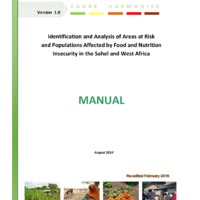Recherche
5 items
Affiche 35e Journée du CILSS
35ème Journée du CILSS : 12 Septembre 2020 Les effets de la Pandémie à COVID-19 sur la sécurité alimentaire et nutritionnelle au Sahel et en Afrique de l'Ouest et les efforts d'adaptation du CILSS pour la production de l'information.
Identification and Analysis of Areas at Risk and Populations Affected by Food and Nutrition Insecurity in the Sahel and West Africa
Facing recurrent food and nutrition insecurity affecting Sahelian and West African populations, governments and their development partners have set up mechanisms to monitor food situation. However, these mechanisms do not use the same methodological approaches, which often lead to results that are difficult to compare and which at times are even contradictory. Aware of this situation and the need to find a suitable solution, CILSS member states and partners have initiated the development of a Cadre harmonisé d’identification et d’analyse des zones à risque et des populations en insécurité alimentaire et nutritionnelle au Sahel et en Afrique de l’Ouest (Harmonized Framework for Identification and Analysis of Areas at Risk of and Populations Affected by Food and Nutrition Insecurity in the Sahel and West Africa). This tool, known as “Cadre Harmonisé” (CH), is expected to serve as a framework for countries to assess food and nutrition insecurity on an objective and consensual basis. The purpose of the Cadre Harmonisé is to help countries prevent food crises better and, where appropriate, quickly identify affected populations and appropriate measures to improve their food and nutrition security. The related method has been developed by a group of food and nutrition security experts from CILSS, FAO, WFP, FEWS NET, AFD, IPC/GSU, JRC/EC and UNICEF, and from international NGOs Oxfam International, Save the Children and ACF1. It is worth recalling that starting from 2008, various meetings held by the CH Technical Committee agreed for the CH to include some elements of the Integrated Food Security Phase classification version 1 (IPC 1.0). The IPC is a set of tools and procedures for classifying food and nutrition insecurity severity for decision making. Since the development of a manual for IPC 2.0, discussions have been under way to bring the CH closer to the IPC to incorporate lessons learned that improve comparability of results from the two tools. Similar to the IPC, the Cadre Harmonisé seeks to make best use of a set of tools and procedures for classifying the nature and severity of current and projected food and nutrition insecurity situations on the basis of a consensual analytical framework and classification scale. The CH is based on the following four conceptual models commonly used by national, regional and global mechanisms: Risk = f (Hazard, Vulnerability) Sustainable Livelihoods Framework The UNICEF Nutrition Conceptual Framework The four dimensions of food security (availability, access, utilization, and stability) The CH therefore is an integrated analytical framework built on a technical consensus that seeks to make best use of data from all systems or methods, namely food consumption surveys, nutrition surveys, the Household Economy Approach (HEA) or other information provided by agricultural surveys and market monitoring. The CH assesses food and nutrition insecurity, based on convergence of evidence from several indicators. The CH uses a food insecurity severity scale with five phases. Such a severity scale, which is an international one, makes it possible to make comparisons between countries of the sub-region and also at global level. CILSS was mandated to develop and implement the CH as a common tool for Sahelian and West African countries. Its analysis cycles will from now on help develop regional mapping of current food and nutrition situations and analyze projected situations. 1 Other institutions such as MIFRAC, IBIMET and CARE International initially contributed to the development of the present analytical framework. Cadre Harmonisé MANUAL Version 1.0 Page | 13 The CH also seeks to strengthen the regional integration framework in the CILSS-ECOWAS-UEMOA region so that collaborative and harmonized analyses of food and nutrition situations are conducted through the best possible use of other tools and analysis methods developed by national mechanisms and partners. Given the importance of the process of harmonizing the analytical framework for food and nutrition situations in West Africa, it is necessary that all food and nutrition security stakeholders take ownership of it and make it their decision-making tool. Furthermore, efforts are needed to strengthen the partnership framework within countries and to support the operations of early warning systems in order to improve the collection of reliable data. CH implementation relies on existing data collection mechanisms. Efforts should be made by countries and partners to provide financial support to these mechanisms - as CH implementation will from now on be the baseline reference for activating regional food reserves and mobilizing technical and financial partners (TFPs).
Rapport régional 2024 sur la sécurité alimentaire et nutritionnelle au Sahel et en Afrique de l’Ouest en bref
Résultat d’un partenariat entre le Comité permanent inter-États de lutte contre la sécheresse dans le Sahel (CILSS) et le Réseau d’information sur la sécurité alimentaire (FSIN), ce rapport fournit des informations
fiables et actualisées nécessaires pour répondre aux défis croissants de la sécurité alimentaire et de la nutrition au Sahel et en Afrique de l’Ouest. La situation alimentaire et nutritionnelle est préoccupante pendant la période de
soudure de 2024. Même s’il y a un nombre significativement inférieur des personnes dans les phases les plus sévères dans plusieurs pays, en termes de nombre et de pourcentage de personnes en Phases CH 3 à 5, les niveaux d’insécurité alimentaire et nutritionnelle sont projetés comme étant les plus élevés enregistrés dans l’histoire du CH. Ces circonstances sont provoquées par
l’interaction entre le conflit et l’insécurité civile, les chocs économiques, les phénomènes météorologiques extrêmes, la pauvreté sous jacente et d’autres facteurs de vulnérabilité.
Rapport Régional 2024 sur la sécurité alimentaire nutritionnelle au Sahel et en Afrique de l'Ouest
Ce rapport régional pour le Sahel et l'Afrique de l'Ouest 2024 donne une évaluation intégrale de l'insécurité alimentaire et nutritionnelle aigue dans la région en 2024. Il est produit par le CILSS en collaboration avec ses partenaires techniques et financiers. Pour la deuxième année consécutive, le réseau d'information sur la sécurité alimentaire et nutritionnelle (FSIN) a soutenu sa production, dans le cadre de leur partenariat visant à renforcer la veille et la diffusion des données et analyse sur les crises alimentaires.
Rapport Régional sur la Sécurité Alimentaire et Nutritionnelle au Sahel et en Afrique de l'Ouest (RRSAN) 2023
Le Rapport Régional (RR) sur la sécurité alimentaire et nutritionnelle est élaboré pour contribuer à nourrir le système de gouvernance de la sécurité alimentaire, de l'agriculture durable et la résilience au Sahel et en Afrique de l'Ouest. C'est un document de synthèse régionale qui regroupe les principales informations produites dans le cadre de l'animation du dispositif de Prevention et de Gestion des Crises Alimentaires (PREGEC) ainsi que du Réseau de Prevention des Crises Alimentaires (RPCA). Ces informations concernent les différentes conditions agroécologiques explicatives de l'environnement de la production agropastorale 2022/2023 déterminant l'essentiel de la situation alimentaire de la région.


